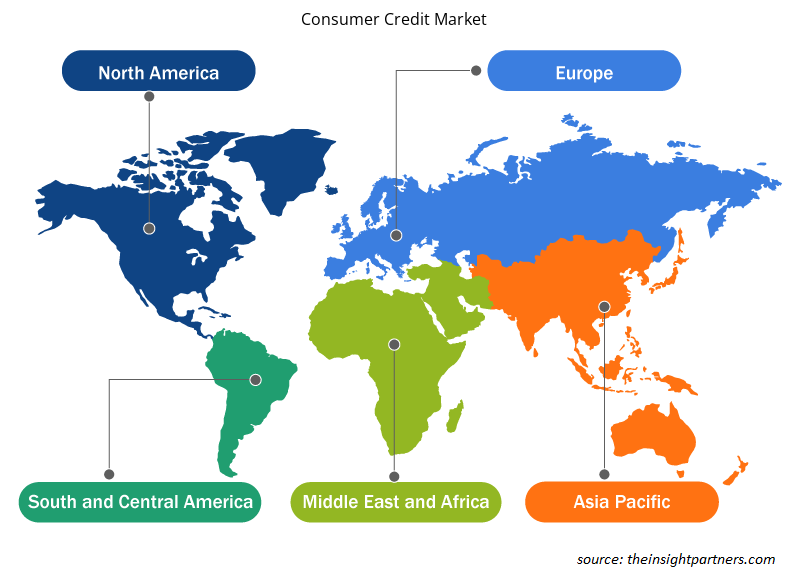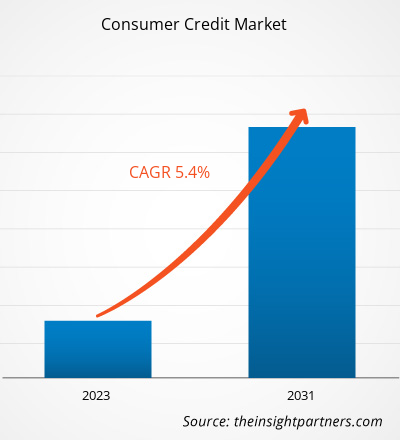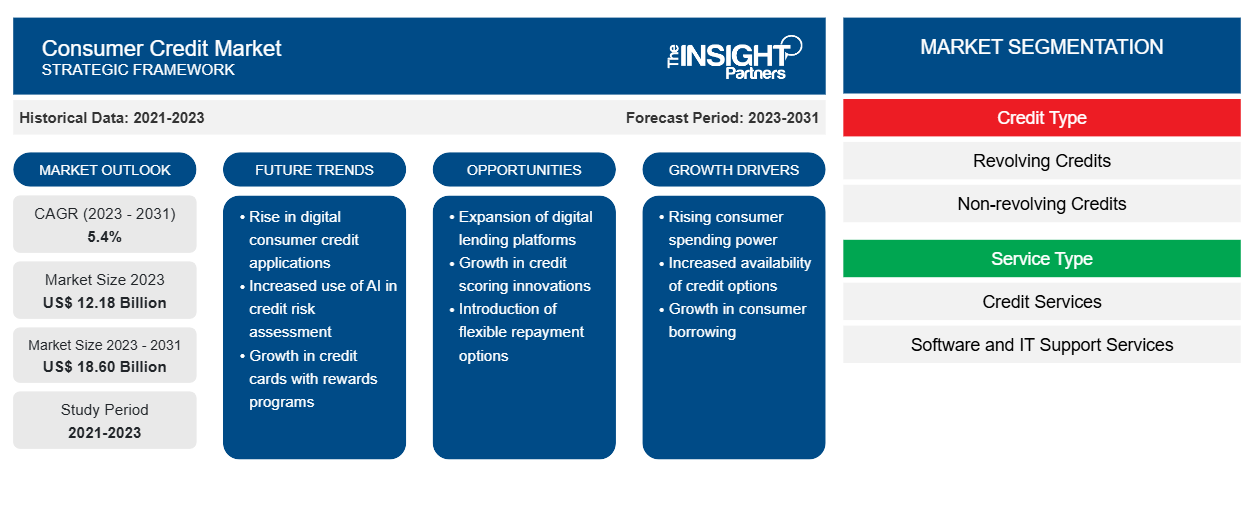소비자 신용 시장 규모는 2023년 121억 8천만 달러에서 2031년 186억 달러로 성장할 것으로 예상되며, 2023년에서 2031년까지 연평균 성장률 5.4%로 확대될 것으로 예상됩니다. 소비자 신용은 종종 소비자 부채라고도 하며, 상품이나 서비스를 취득하기 위해 발생한 개인 부채입니다. 모든 종류의 개인 대출은 소비자 신용으로 분류될 수 있지만, 이 문구는 일반적으로 소액의 무담보 부채를 나타내는 데 사용됩니다. 소비자 신용 통계는 경제의 건강을 모니터링하는 핵심 지표입니다. 특정 경제에서 소비자의 구매력을 전달합니다.
소비자 신용 시장 분석
신용은 그렇지 않으면 특정 상품을 살 여유가 없는 고객에게 소비를 가능하게 하는 중요한 요소입니다. 더 많은 사람들이 온라인에서 쇼핑을 함에 따라 민첩한 기술 기업이 자주 설계하고 고객 여정에 완벽하게 통합하는 POS 금융을 위한 혁신적인 디지털 솔루션이 기존 은행의 부적절한 디지털 역량에 신중한 밀레니얼 세대 쇼핑객 사이에서 인기를 얻고 있습니다. 기술의 발전과 지원 규제로 인해 이러한 새로운 경쟁자는 기존 은행의 대출 가치 사슬에 대한 통제를 방해하고 더 빠르고 개인화되고 효율적인 서비스 제공을 기반으로 경쟁하기가 더 쉬워졌습니다. 이전에 소비자를 은행에 묶어두었던 충성심과 무기력함은 규제로 인해 여러 금융 서비스 제공업체와 파트너십을 맺기가 그 어느 때보다 쉬워지면서 유럽 전역에서 사라지고 있습니다.
소비자 신용
산업 개요
- 소비자 신용 시장 성장을 주도하는 주요 요인 중 일부는 도시 생활 방식의 변화, 전 세계 모든 지역에서 전자 상거래의 급속한 확산, 기술 발전 등입니다. 예를 들어, 인공지능의 도입은 소비자 대출의 기본 프로세스를 바꿀 것입니다. AI 기술은 행정 업무를 개선하고 단순화하도록 설계되어 은행 직원이 고객 연결에 더 많은 시간을 할애할 수 있습니다. AI 기반 상호 작용을 통해 원활한 고객 온보딩 과 위험 및 규정 준수 업무에 대한 처리 시간이 단축됩니다. 긍정적인 소비자 경험은 고객 충성도와 추천을 높일 수 있습니다.
- 한 국가의 소비자 신용 사업은 해당 국가의 소비자 지출 행동에 크게 좌우됩니다. 예를 들어, 영국에서 소비자 카드 지출은 2023년에 전년 대비 4.1%만 증가했는데, 이는 2022년(10.6%)에 관찰된 성장률보다 훨씬 낮았습니다. 이는 영국인들이 인플레이션과 가족 비용 증가로 인해 새 옷, 외식, 주택 개량을 줄였기 때문입니다. 반면 소비자들은 즐거움과 공유 경험을 우선시하여 여행, 엔터테인먼트, 술집과 바의 성장을 이끌었습니다.
귀하의 요구 사항에 맞게 이 보고서를 사용자 정의하세요
이 보고서의 일부 또는 국가 수준 분석, Excel 데이터 팩을 포함하여 모든 보고서에 대한 사용자 정의를 무료로 받을 수 있으며 신생 기업 및 대학을 위한 훌륭한 혜택과 할인 혜택을 이용할 수 있습니다.
- 이 보고서의 주요 시장 동향을 알아보세요.이 무료 샘플에는 시장 동향부터 추정 및 예측까지 다양한 데이터 분석이 포함됩니다.
소비자 신용 시장 드라이버
소비자 신용 시장을 주도하는 지출 유연성에 대한 수요
- 소비자 대출을 제공하면 오늘날의 고객이 원하는 유연성을 제공하여 전환율을 높입니다. Foreign & Colonial Investment Trust의 Millennial Money Survey에 따르면, 밀레니얼 세대의 16%는 매달 돈을 저축하지 않으며, 780만 명은 전혀 저축하지 않습니다.
- 밀레니얼 세대는 주택과 자동차와 같은 전통적인 자산 소유보다 여행, 외식, 엔터테인먼트와 같은 경험을 더 중요하게 여기는 경우가 많습니다. 그 결과, 개인은 이러한 경험에 자금을 지원하기 위해 신용카드와 개인 대출에 더 의존할 수 있으며, 이는 소비자 신용 시장의 수요를 촉진합니다.
소비자 신용
시장 보고서 세분화 분석
- 소비자 신용 시장 보고서는 신용 유형에 따라 회전 신용과 비회전 신용으로 구분됩니다.
- 신용 카드를 포함한 리볼빙 신용은 모든 구매에 사용할 수 있습니다. 신용은 "리볼빙"으로, 신용 한도가 열려 있고 대출인이 최소 월 상환금을 정기적으로 계속 지불하는 한 전체 한도까지 반복적으로 사용할 수 있다는 의미입니다.
소비자 신용
지역별 시장 분석
소비자 신용 시장 보고서의 범위는 주로 북미, 유럽, 아시아 태평양, 중동 및 아프리카, 남미의 5개 지역으로 나뉩니다. 북미는 급속한 성장을 경험하고 있으며 상당한 소비자 신용 시장 점유율을 차지할 것으로 예상됩니다. 이 지역의 상당한 경제 발전, 인구 증가, 위험 관리 및 보험에 대한 집중 증가가 이러한 성장에 기여했습니다. 북미는 미국과 캐나다와 같은 많은 개발도상국의 본거지이며, 소비자 신용 시장 성장을 주도하고 있습니다.
소비자 신용
소비자 신용 시장 지역 통찰력
Insight Partners의 분석가들은 예측 기간 동안 소비자 신용 시장에 영향을 미치는 지역적 추세와 요인을 철저히 설명했습니다. 이 섹션에서는 북미, 유럽, 아시아 태평양, 중동 및 아프리카, 남미 및 중미의 소비자 신용 시장 세그먼트와 지리적 분포도 논의합니다.

- 소비자 신용 시장에 대한 지역별 특정 데이터 얻기
소비자 신용 시장 보고서 범위
| 보고서 속성 | 세부 |
|---|---|
| 2023년 시장 규모 | 121억 8천만 달러 |
| 2031년까지 시장 규모 | 186억 달러 |
| 글로벌 CAGR (2023-2031) | 5.4% |
| 역사적 데이터 | 2021-2023 |
| 예측 기간 | 2023-2031 |
| 다루는 세그먼트 | 신용 유형별
|
| 포함된 지역 및 국가 | 북아메리카
|
| 시장 선도 기업 및 주요 회사 프로필 |
|
소비자 신용 시장 플레이어 밀도: 비즈니스 역학에 미치는 영향 이해
소비자 신용 시장 시장은 소비자 선호도의 변화, 기술 발전, 제품의 이점에 대한 인식 증가와 같은 요인으로 인해 최종 사용자 수요가 증가함에 따라 빠르게 성장하고 있습니다. 수요가 증가함에 따라 기업은 제품을 확장하고, 소비자의 요구를 충족하기 위해 혁신하고, 새로운 트렌드를 활용하여 시장 성장을 더욱 촉진하고 있습니다.
시장 참여자 밀도는 특정 시장이나 산업 내에서 운영되는 회사나 기업의 분포를 말합니다. 주어진 시장 공간에 얼마나 많은 경쟁자(시장 참여자)가 존재하는지 그 규모나 총 시장 가치에 비해 나타냅니다.
소비자 신용 시장에서 운영되는 주요 회사는 다음과 같습니다.
- 아멕스 카드
- 미국은행
- 시티
- 웰스파고은행
- 캐피탈 원 뱅크
면책 조항 : 위에 나열된 회사는 어떤 특별한 순서에 따라 순위가 매겨지지 않았습니다.

- 소비자 신용 시장의 주요 참여자 개요를 알아보세요
"소비자 신용 시장 분석"핵심 투자 전략과 지리적 위치를 기반으로 수행되었습니다. 신용 유형 측면에서 시장은 회전 신용과 비회전 신용으로 세분화됩니다. 지리적 위치를 기준으로 시장은 북미, 유럽, 아시아 태평양, 중동 및 아프리카, 남미로 세분화됩니다.
소비자 신용
시장 뉴스 및 최근 개발 사항
기업들은 소비자 신용 시장에서 합병 및 인수와 같은 무기적 및 유기적 전략을 채택합니다. 최근 몇 가지 주요 시장 개발은 다음과 같습니다.
- 2024년 2월, Barclays PLC와 Blackstone Credit & Insurance는 오늘 Barclays Bank Delaware가 Blackstone의 자산 기반 금융 그룹이 관리하는 보험 계좌와 계약을 체결하여 미국 내 정의된 Barclays 브랜드 신용카드 계좌와 관련하여 현재 미지급 신용카드 미수금 약 11억 달러를 매각한다고 발표했습니다. 이는 Barclays가 위험 가중 자산(RWA)을 줄이고 BBDE에 대한 추가 대출 용량을 창출하기 위해 수행할 일련의 활동 중 첫 번째입니다.
[출처: Barclays PLC, 회사 홈페이지]
소비자 신용
시장 보고서 범위 및 제공물
시장 보고서 "소비자 신용 시장 규모 및 예측(2021-2031)"은 아래 영역을 포괄하는 시장에 대한 자세한 분석을 제공합니다.
- 범위에 포함된 모든 주요 시장 부문에 대한 글로벌, 지역 및 국가 수준의 시장 규모와 예측입니다.
- 시장 역학에는 동인, 제약, 주요 기회 등이 있습니다.
- 주요 미래 트렌드
- 자세한 PEST 및 SWOT 분석
- 주요 시장 동향, 주요 업체, 규정, 최근 시장 개발 사항을 다루는 글로벌 및 지역 시장 분석입니다.
- 시장 집중도, 히트맵 분석, 주요 업체 및 최근 개발 사항을 포괄하는 업계 환경 및 경쟁 분석입니다.
- 자세한 회사 프로필
- 과거 분석(2년), 기준 연도, CAGR을 포함한 예측(7년)
- PEST 및 SWOT 분석
- 시장 규모 가치/거래량 - 글로벌, 지역, 국가
- 산업 및 경쟁 환경
- Excel 데이터세트
최근 보고서
사용 후기
구매 이유
- 정보에 기반한 의사 결정
- 시장 역학 이해
- 경쟁 분석
- 고객 인사이트
- 시장 예측
- 위험 완화
- 전략 기획
- 투자 타당성 분석
- 신흥 시장 파악
- 마케팅 전략 강화
- 운영 효율성 향상
- 규제 동향에 발맞춰 대응























 무료 샘플 받기 - 소비자 신용 시장
무료 샘플 받기 - 소비자 신용 시장